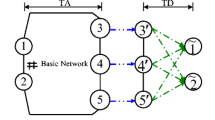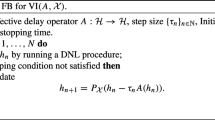Abstract
This paper presents two novel algorithmic frameworks to address the logit-based stochastic user equilibrium traffic assignment problem (SUE-TAP). Following the different variant of the gradient projection (termed as GP2) algorithm, we propose an improved GP2 algorithm (IGP) for the SUE-TAP. This study initially presents a smart approach for determining the allocation of more or less effort to specific origin–destination (OD) pairs. Subsequently, the TAP can be decomposed by different OD pairs, whereas the proposed IGP algorithm is designed based on the serial scheme (i.e., the Gauss–Seidel method). Therefore, a new parallel algorithm P-IGP is proposed, which integrates the block coordinate descent (BCD) method and the IGP algorithm. In specific, the independent OD pairs can be separated into several blocks, and the OD-based restricted subproblems within each block can be solved in parallel. Then, we outline the entire process of implementing the P-IGP algorithm to address the SUE-TAP. Several numerical experiments are conducted to verify the proposed algorithms. The results reveal that the proposed IGP algorithm demonstrates significantly speeder convergence in comparison to the traditional GP2 algorithm, achieving a remarkable acceleration of approximately 12%. Furthermore, the performance of the P-IGP algorithm surpasses that of the proposed IGP algorithm, and it can further achieve a notable 4–5-fold enhancement in convergence efficiency.









Similar content being viewed by others
Data Availability
The network data used in this study are publicly available, and it is accessible on the website: https://github.com/bstabler/TransportationNetworks.
References
Aboudina A, Abdulhai B (2017) A bi-level distributed approach for optimizing time-dependent congestion pricing in large networks: A simulation-based case study in the Greater Toronto Area. Transp Res Part C Emerg Technol 85:684–710
Akamatsu T (1996) Cyclic flows, Markov process and stochastic traffic assignment. Transp Res Part B Methodol 30(5):369–386
Akamatsu T (1997) Decomposition of path choice entropy in general transport networks. Transp Sci 31(4):349–362
Akuh R, Zhong M, Raza A, Dong Y (2023) A method for evaluating the balance of land use and multimodal transport system of new towns/cities using an integrated modeling framework. Multimodal Transp 2(1):100063
Ameli M, Lebacque JP, Leclercq L (2020) Simulation-based dynamic traffic assignment: Meta-heuristic solution methods with parallel computing. Comput-Aided Civil Infrastruct Eng 35(10):1047–1062
Balzer L, Leclercq L (2022) Modal equilibrium of a tradable credit scheme with a trip-based MFD and logit-based decision-making. Transp Res Part C Emerg Technol 139:103642
Bar-Gera H (2002) Origin-based algorithm for the traffic assignment problem. Transp Sci 36(4):398–417
Bar-Gera H, Boyce D, Nie Y (2012) User-equilibrium route flows and the condition of proportionality. Transp Res Part B Methodol 46(3):440–462
Beck A, Tetruashvili L (2013) On the convergence of block coordinate descent type methods. SIAM J Optim 23(4):2037–2060
Bekhor S, Toledo T (2005) Investigating path-based solution algorithms to the stochastic user equilibrium problem. Transp Res Part B Methodol 39(3):279–295
Bekhor S, Reznikova L, Toledo T (2007) Application of cross-nested logit route choice model in stochastic user equilibrium traffic assignment. Transp Res Rec 2003(1):41–49
Bell MGH (1995) Alternatives to Dial’s logit assignment algorithm. Transp Res Part B Methodol 29(4):287–295
Bell MGH (1995) Stochastic user equilibrium assignment in networks with queues. Transp Res Part B Methodol 29(2):125–137
Chen R, Meyer RR (1988) Parallel optimization for traffic assignment. Math Program 42(2):327–345
Chen A, Jayakrishnan R, Tsai WK (2002) Faster Frank-Wolfe traffic assignment with new flow update scheme. J Transp Eng 128(1):31–39
Chen A, Xu X, Ryu S, Zhong Z (2013) A self-adaptive Armijo stepsize strategy with application to traffic assignment models and algorithms. Transportmetrica A Transp Sci 9(7–8):695–712
Chen X, Liu Z, Zhang K, Wang Z (2020) A parallel computing approach to solve traffic assignment using path-based gradient projection algorithm. Transp Res Part C Emerg Technol 120:102809
Daganzo CF, Sheffi Y (1977) On stochastic models of traffic assignment. Transp Sci 11(3):83–111
Damberg O, Lundgren JT, Patriksson M (1996) An algorithm for the stochastic user equilibrium problem. Transp Res Part B Methodol 30(2):115–131
Dial RB (1971) A probabihstic multipath traffic assignment algorithm which obviates path enumeration. Transp Res 5(2):83–111
Du M, Tan H, Chen A (2021) A faster path-based algorithm with Barzilai-Borwein step size for solving stochastic traffic equilibrium models. Eur J Oper Res 290(3):982–999
Fercoq O, Richtarik P (2015) Accelerated, parallel, and proximal coordinate descent. SIAM J Optim 25(4):1997–2023
Fisk C (1980) Some developments in equilibrium traffic assignment. Transp Res Part B Methodol 14(3):243–255
Florian M, Gendreau M (2001) Applications of parallel computing in transportation. Parallel Comput 27(12):1521–1522
Galligari A, Sciandrone M (2018) A convergent and fast path equilibration algorithm for the traffic assignment problem. Optim Methods Softw 33(2):354–371
Gentile G (2014) Local User Cost Equilibrium: a bush-based algorithm for traffic assignment. Transportmetrica A Transp Sci 10(1):15–54
Grippo L, Sciandrone M (2000) On the convergence of the block nonlinear Gauss-Seidel method under convex constraints. Oper Res Lett 26(3):127–136
Gu Y, Chen A, Kitthamkesorn S (2022) Accessibility-based vulnerability analysis of multi-modal transportation networks with weibit choice models. Multimodal Transp 1(3):100029
Guo X, Yang H, Liu T-L (2010) Bounding the inefficiency of logit-based stochastic user equilibrium. Eur J Oper Res 201(2):463–469
Huang H, Li Z (2007) A multiclass, multicriteria logit-based traffic equilibrium assignment model under ATIS. Eur J Oper Res 176(3):1464–1477
Huang D, Wang S (2022) A two-stage stochastic programming model of coordinated electric bus charging scheduling for a hybrid charging scheme. Multimodal Transp 1(1):100006
Jafari E, Pandey V, Boyles SD (2017) A decomposition approach to the static traffic assignment problem. Transp Res Part B Methodol 105:270–296
Janson BN, Southworth F (1992) Estimating departure times from traffic counts using dynamic assignment. Transp Res Part B Methodol 26(1):3–16
Jiang Y, Nielsen OA (2022) Urban multimodal traffic assignment. Multimodal Transp 1(3):100027
Larsson T, Patriksson M (1992) Simplicial decomposition with disaggregated representation for the traffic assignment problem. Transp Sci 26(1):4–17
Lee D, Meng Q, Deng W (2010) Origin-based partial linearization method for the stochastic user equilibrium traffic assignment problem. J Transp Eng-Asce 136(1):52–60
Leventhal D, Lewis AS (2010) Randomized methods for linear constraints: convergence rates and conditioning. Math Oper Res 35(3):641–654
Liu Z, Meng Q (2013) Distributed computing approaches for large-scale probit-based stochastic user equilibrium problems. J Adv Transp 47(6):553–571
Liu H, He X, He B (2009) Method of successive weighted averages (MSWA) and self-regulated averaging schemes for solving stochastic user equilibrium problem. Netw Spat Econ 9(4):485–503
Liu Z, Wang S, Meng Q (2014) Optimal joint distance and time toll for cordon-based congestion pricing. Transp Res Part B Methodol 69:81–97
Liu Z, Zhang H, Zhang K, Zhou Z (2023) Integrating alternating direction method of multipliers and bush for solving the traffic assignment problem. Transp Res Part E Logist Transp Rev 177:103233
Liu Z, Chen X, Hu J, Wang S, Zhang K, Zhang H (2023) An alternating direction method of multipliers for solving user equilibrium problem. Eur J Oper Res 310:1072–1084
Maher M (1998) Algorithms for logit-based stochastic user equilibrium assignment. Transp Res Part B Methodol 32(8):539–549
Patrascu A, Necoara I (2015) Efficient random coordinate descent algorithms for large-scale structured nonconvex optimization. J Global Optim 61(1):19–46
Patriksson M (1994) The traffic Assignment Problem: Models and Methods. Courier Dover Publications
Powell WB, Sheffi Y (1982) The convergence of equilibrium algorithms with predetermined step sizes. Transp Sci 16(1):45–55
Ren Q, Xu M (2024) Injury severity analysis of highway-rail grade crossing crashes in non-divided two-way traffic scenarios: A random parameters logit model. Multimodal Transp 3(1):100109
Sheffi Y (1985) Urban transportation networks: equilibrium analysis with mathematical programming methods. Prentice Hall, Englewood Cliffs, NJ
Sheffi Y, Powell WB (1982) An algorithm for the equilibrium assignment problem with random link times. Networks 12(2):191–207
Smith MJ, Watling DP (2016) A route-swapping dynamical system and Lyapunov function for stochastic user equilibrium. Transp Res Part B Methodol 85:132–141
Sun S, Szeto WY (2018) Logit-based transit assignment: Approach-based formulation and paradox revisit. Transp Res Part B Methodol 112:191–215
Wang H (2022) Transportation-enabled urban services: A brief discussion. Multimodal Transp 1(2):100007
Wang Z, Zhang K, Chen X, Wang M, Liu R, Liu Z (2021) An improved parallel block coordinate descent method for the distributed computing of traffic assignment problem. Transportmetrica A Transp Sci 18(3):1376–1400
Wardrop JD (1952) Some theoretical aspects of road traffic research. Proc Inst Civil Eng 1(3):325–362
Watling D (2006) User equilibrium traffic network assignment with stochastic travel times and late arrival penalty. Eur J Oper Res 175(3):1539–1556
Watling DP, Rasmussen TK, Prato CG, Nielsen OA (2018) Stochastic user equilibrium with a bounded choice model. Transp Res Part B Methodol 114:254–280
Xie J, Nie Y, Liu X (2018) A greedy path-based algorithm for traffic assignment. Transp Res Rec 2672(48):36–44
Yang H (1999) System optimum, stochastic user equilibrium, and optimal link tolls. Transp Sci 33(4):354–360
Yang D, Cheng D, Rang W, Wang Y (2022) Joint optimization of MapReduce scheduling and network policy in hierarchical data centers. IEEE Trans Cloud Comput 10(1):461–473
Ying J, Miyagi T (2001) Sensitivity analysis for stochastic user equilibrium network flows - A dual approach. Transp Sci 35(2):124–133
Zhang H, Liu Z, Wang J, Wu Y (2023) A novel flow update policy in solving traffic assignment problems: Successive over relaxation iteration method. Transp Res Part E Logist Transp Rev 174:103111
Zhang K, Zhang H, Cheng Q, Chen X, Wang Z, Liu Z (2023) A customized two-stage parallel computing algorithm for solving the combined modal split and traffic assignment problem. Comput Oper Res 154(4):106193
Zhou B, Li X, He J (2014) Exploring trust region method for the solution of logit-based stochastic user equilibrium problem. Eur J Oper Res 239(1):46–57
Funding
This study is supported by the Key Project (No. 52131203) of National Natural Science Foundation of China.
Author information
Authors and Affiliations
Contributions
Conceptualization: Honggang Zhang and Zhiyuan Liu; Methodology: Honggang Zhang, Zhiyuan Liu, and Yicheng Zhang; Formal analysis and investigation: Honggang Zhang, Weijie Chen, and Chenyang Zhang; Writing-review and editing: Honggang Zhang, Zhiyuan Liu, and Yicheng Zhang; Funding acquisition: Zhiyuan Liu; Writing-original draft: Honggang Zhang. All authors reviewed the manuscript.
Corresponding author
Ethics declarations
Ethical Approval
Not applicable.
Competing Interests
The authors declare no competing interests.
Additional information
Publisher's Note
Springer Nature remains neutral with regard to jurisdictional claims in published maps and institutional affiliations.
Rights and permissions
Springer Nature or its licensor (e.g. a society or other partner) holds exclusive rights to this article under a publishing agreement with the author(s) or other rightsholder(s); author self-archiving of the accepted manuscript version of this article is solely governed by the terms of such publishing agreement and applicable law.
About this article
Cite this article
Zhang, H., Liu, Z., Zhang, Y. et al. A Distributed Computing Method Integrating Improved Gradient Projection for Solving Stochastic Traffic Equilibrium Problem. Netw Spat Econ (2024). https://doi.org/10.1007/s11067-024-09617-3
Accepted:
Published:
DOI: https://doi.org/10.1007/s11067-024-09617-3




